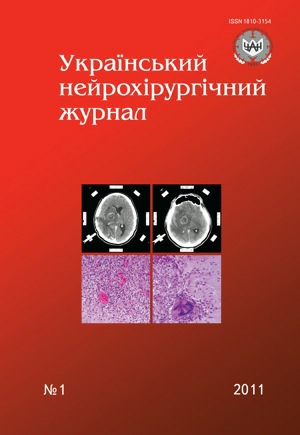Application of epidural electrostimulation method in renewing surgical treatment of patients with consequences of cervical spine traumatic injury
DOI:
https://doi.org/10.25305/unj.58428Keywords:
spinal trauma, epidural electrostimulation, movements renewing, neuropathic pain syndrome, spasticityAbstract
Working out of new methods of surgical treatment, aimed to renew spinal cord function and to improve life quality of patients with consequences it’s traumatic injury, is one of the most perspective directions of modern neurosurgery development.
The results of epidural electrostimulation application at 59 patients with consequences of cervical spine injury are given. Movements renewing was estimated according to ASIA and Frankel scales. Pain syndrome intensity was estimated by VAS and NRS scales, the spasticity — by Ashworth.
Renewing and improvement of movements in upper limbs was observed at 56 (94.9%) patients, renewing of movements in lower limbs — at 6 (10.2%), their improvement — at 7 (11.9%). The ability to walk was renewed at 5 (8.5%) patients, was improved — at 2 (3.4%). Positive results in neuropathic pain syndrome correction were obtained at 6 (85.7%) of 7 patients, in spasticity — at 9 (81.8%) patients of 11, bladder function was improved at 39 (66.1%).
Results of spinal cord functions renewing using epidural electrostimulation are directly proportional to trauma severity and duration of injury existence.
References
Outcome of decompression surgery for cervical spinal cord injury without bone and disc injury in patients with spinal cord compression: a multicenter prospective study / O. Kawano, T. Ueta, K. Shiba, et al. // Spinal Cord. — 2010. — V.12. — P.32–38.
Fehlings M.G. The role and timing of early decompression for cervical spinal cord injury: update with a review of recent clinical evidence / M.G. Fehlings, R.G. Perrin // Injury. — 2005. — V.36. — P.13–26.
Urgent surgical decompression compared to methylprednisolone for the treatment of acute spinal cord injury: a randomized prospective study in beagle dogs / R.S. Rabinowitz, J.C. Eck, C.M. Jr. Harper, et al. // Spine. — 2008. — V.33. — P.2260–2268.
Popovic M.R. Neuroprostheses for grasping / M.R. Popovic, D.B. Popovic, T. Keller // Neurol. Res. — 2002. — V.24. — P.443–452.
Tsymbaliuk V, Chebotariova L, Iaminskiy I. Embrional tissue transplantation as a method of spinal cord recovery after experimental injury. / Ukrainian Neurosurgical Journal. — 2002. — №1. — P.69–76.
Krishnan R.V. Spinal cord injury repair research: a new combination treatment strategy / R.V. Krishnan, R. Muthusamy, V. Sankar // Int. J. Neurosci. — 2001. — V.108. — P.201–207.
Funtional recovery of paraplegic rats and motor axon regeneration in their spinal cord by olfactory ensheanthing glia / A. Ramon-Cueto, M.I. Cordero., E.F. Santos-Benito, et al. // Neuron. — 2000. — V.25. — P.425–435.
The ability of human Schwann cell grafts to promote regeneration in the transected nude rat spinal cord / J.D. Guest, A. Rao, O. Olson, et al. // Exp. Neurol. — 1997. — V.148. — P.502–522.
Facilitation of stepping with epidural stimulation in spinal rats: role of sensory input / I. Lavrov, G. Courtine, C. Dy , et al. // J. Neurosci. — 2008. — V.28. — P.7774–7783.
Hamid S. Role of electrical stimulation for rehabilitation and regeneration after spinal cord injury /S. Hamid, D. Hayek // Eur. Spine J. — 2008. — V.17. — P.1256–1269.
Complete spinal cord injury treatment using autologous bone marrow cell transplantation and bone marrow stimulation with granulocyte macrophage-colony stimulating factor: Phase I/II clinical trial / S. Yoon, Y. Shim, Y. Park, et al. // Eur. Spine J. — 2009. — V.20. — P.1456–1469.
Spinal cord stimulation facilitates functional walking in a chronic, incomplete spinal cord injured / R. Herman, J. He,S. Luzansky, et al. // Spinal Cord. — 2002. — V.40. — P.65–68.
Hill C.E. Degeneration and sprouting of idintified descending supraspinal axons after contusive spinal cord injury in the rat / C.E. Hill, M.S. Beattie, J.C. Bresnahan // Exp. Neurol. — 2001. — V.171, N1. — Р.153–169.
Tator C.H. Biology of neurological recovery and functional restoration after spinal cord injury / C.H. Tator // Neurosurgery. — 2000. — V.42. — P.696–708.
Hamid S. Role of electrical stimulation for rehabilitation and regeneration after spinal cord injury: an overview / S. Hamid, R. Hayek // Eur. Spine. — 2008. — V.17. — P.1256–1269.
Epidural stimulation induced modulation of spinal locomotor networks in adult spinal rats / I. Lavrov, C.J. Dy, A.J. Fong, et al. // J. Neurosci. — 2008. — V.28. — P.6022–6029.
Oscillating field stimulation for complete spinal cord injury in humans: a phase 1 trial / S. Shapiro, R.B. Borgens, R. Pascuzzi [et al.] // J. Neurosurg. Spine. — 2005. — V.2. — P.3–10.
Downloads
Published
How to Cite
Issue
Section
License
Copyright (c) 2011 Vitaliy Tsymbaliuk, Iuriy Iaminskiy

This work is licensed under a Creative Commons Attribution 4.0 International License.
Ukrainian Neurosurgical Journal abides by the CREATIVE COMMONS copyright rights and permissions for open access journals.
Authors, who are published in this Journal, agree to the following conditions:
1. The authors reserve the right to authorship of the work and pass the first publication right of this work to the Journal under the terms of Creative Commons Attribution License, which allows others to freely distribute the published research with the obligatory reference to the authors of the original work and the first publication of the work in this Journal.
2. The authors have the right to conclude separate supplement agreements that relate to non-exclusive work distribution in the form of which it has been published by the Journal (for example, to upload the work to the online storage of the Journal or publish it as part of a monograph), provided that the reference to the first publication of the work in this Journal is included.









